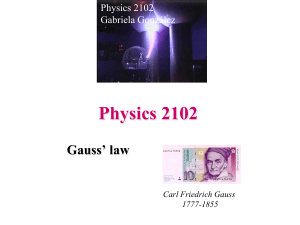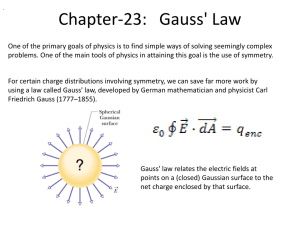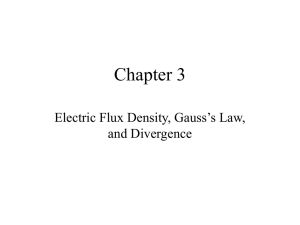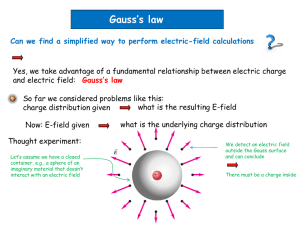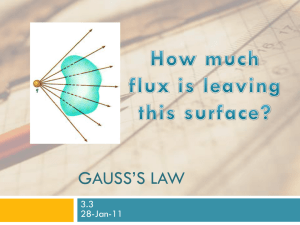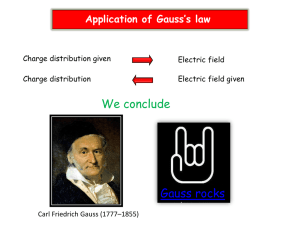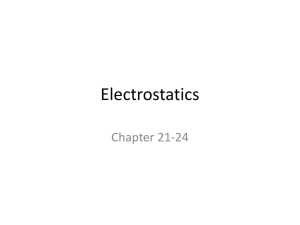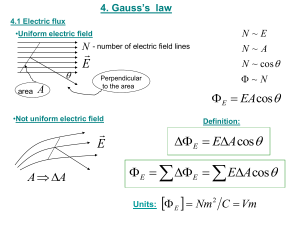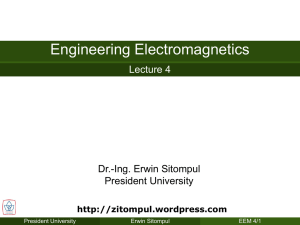Engr302 - Lecture 3
advertisement
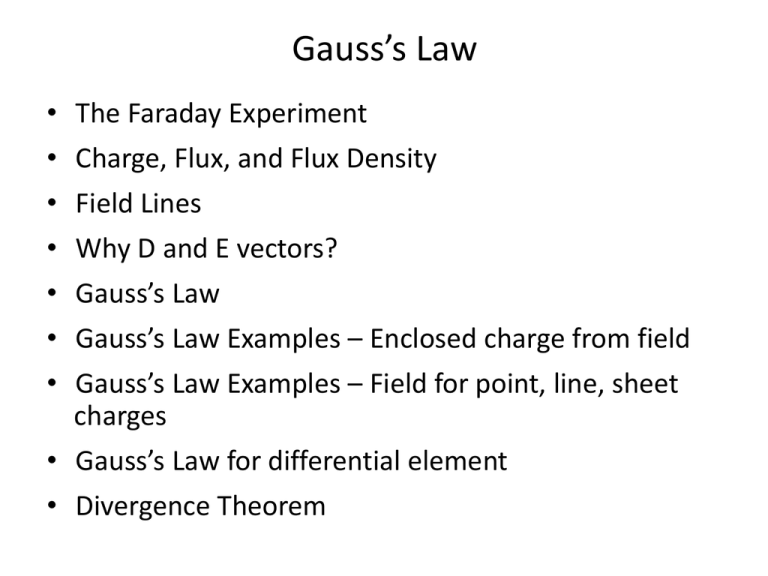
Gauss’s Law • The Faraday Experiment • Charge, Flux, and Flux Density • Field Lines • Why D and E vectors? • Gauss’s Law • Gauss’s Law Examples – Enclosed charge from field • Gauss’s Law Examples – Field for point, line, sheet charges • Gauss’s Law for differential element • Divergence Theorem That Faraday Experiment • Concentric Spheres – Put +Q on inner sphere – Pack dielectric around inner sphere – Assemble outer sphere – Discharge outer sphere – Disassemble and measure induced charge on outer sphere (not sure how you do this?) • Result – Induced charge outer sphere equal to charge on inner sphere – Regardless of dielectric (which modifies local electric field) – Continuity of Displacement, or Displacement Flux, or Electric Flux 𝑄𝑖𝑛𝑛𝑒𝑟 = Ψ = 𝑄𝑜𝑢𝑡𝑒𝑟 Charge, Flux, and Flux Density 1. Charge equals flux 𝑄𝑖𝑛𝑛𝑒𝑟 = Ψ = 𝑄𝑜𝑢𝑡𝑒𝑟 2. Flux density equals flux/area Ψ Ψ 𝐷 = 𝐴𝑟𝑒𝑎 = 4𝜋𝑟 2 • Since 𝑄𝑖𝑛𝑛𝑒𝑟 = Ψ = 𝑄𝑜𝑢𝑡𝑒𝑟 = 𝑄 𝑫𝑟=𝑎 = Ψ 4𝜋𝑎2 = 𝑄 𝒂 4𝜋𝑎2 𝒓 𝑫𝑟=𝑏 = Ψ 4𝜋𝑏2 = 𝑄 𝒂 4𝜋𝑏2 𝒓 𝑄 𝑫 = 4𝜋𝑏2 𝒂𝒓 𝑎<𝑟<𝑏 • For point charge 𝑫= 𝑄 𝒂 4𝜋𝑏2 𝒓 (gauss) 𝑬= 𝑄 𝒂 4𝜋𝜺𝒐 𝑏2 𝒓 (coulomb) 𝒔𝒐 𝑫 = 𝜺𝒐 𝑬 Field Lines • Field Lines 1. Field lines begin on (+) charge and end on (–) charge. 2. Number of Field lines proportional to Ψ and Q. 3. Point in direction of D. 4. D magnitude equal to (field lines)/(area). • Gauss’s Law for sphere 𝑄 = Ψ = 𝑓𝑖𝑒𝑙𝑑 𝑙𝑖𝑛𝑒𝑠 = 𝑓𝑖𝑒𝑙𝑑 𝑙𝑖𝑛𝑒𝑠 𝑎𝑟𝑒𝑎 ∙ 𝑎𝑟𝑒𝑎 = 𝐷 ∙ 4𝜋𝑟 2 • Similar to Coulomb’s Law 𝑫= 𝜌𝑣 𝑑𝑣 𝒂 4𝜋𝑅 2 𝒓 𝑬= 𝜌𝑣 𝑑𝑣 𝒂 4𝜋𝜀𝑜 𝑅 2 𝒓 𝑫 = 𝜺𝒐 𝑬 Why the D and E Vector? Charged plates with dielectric • Displacement (D). – Only free charge density. 𝐷= Ψ 𝐴 𝑄 =𝐴 – Independent of dielectric. • Polarization (P) – – – – Dipole moment of aligned charge. 𝐩 = 𝐐𝐝 𝑷 = 𝒑 Points (-) to (+) for aligned charge. Same direction as D 𝜺𝒐 E 𝐏 𝐃 • Electric Field (E) – Reduced by aligned charge – Add E and P 𝑫 = 𝜀𝑜 𝑬 + 𝑷 𝑷 = 𝜒𝑜 𝜀𝑜 𝑬 (all units C/m2) 𝑫 = 𝜀𝑜 𝑬 + 𝜒𝑜 𝜀𝑜 𝑬 = 𝜀𝑟 𝜀𝑜 𝑬 𝜀𝑟 = 𝜒𝑜 + 1 Gauss’s Law The electric flux passing through any closed surface equals the total charge enclosed by that surface. 𝑄𝑒𝑛𝑐𝑙 = 𝑑Ψ = 𝑫 ∙ 𝒅𝑺 • Universal flux/charge “balance” – (+) Net flux equals (+) charge enclosed. – (-) Net flux equals (-) charge enclosed. – (0) Net Flux equals (0) net charge enclosed. • Define Gaussian Surface. – Dot product of D and dS. – (dS outward normal). – dot product 𝑫 ∙ 𝒅𝑺 • Outward (+) • Inward (-) • Glancing (0) – Integrate over closed surface. – Exploit Symmetry. Gauss’s Law for charge distributions • Charge enclosed can be – Discrete charge – Line charge – Surface charge – Volume charge • For volume Gauss’s Law becomes Example 1 – Enclosed charge from field • Find charge enclosed by field at r Integrate over sphere, Take divergence in spherical coordinates! 𝑄 𝑫= 𝒂 4𝜋𝑟 2 𝒓 • Make symmetry assumption (sphere) • Choose vector area element 𝑑𝑺 = 𝑟 2 𝑠𝑖𝑛𝜃 𝑑𝜃 𝑑𝜑 𝒂𝒓 • Form dot product integrand 𝑫 ∙ 𝑑𝑺 = • 𝑄 𝑟 2 𝑠𝑖𝑛𝜃 4𝜋𝑟 2 𝑑𝜃 𝑑𝜑 𝒂𝒓 ∙ 𝒂𝒓 Integrate over closed surface to get flux Ψ = Q 2𝜋 𝜋 0 0 𝑄 𝑄 𝑠𝑖𝑛𝜃 𝑑𝜃 𝑑𝜑 = 4𝜋 2 𝜋 𝑠𝑖𝑛𝜃 𝑑𝜃 = 0 𝑄 −𝑐𝑜𝑠𝜃0 𝜋 = 𝑄 2 Example 2 – Enclosed charge from field • Find E at 𝑟 = 2, 𝜃 = 25, 𝜑 = 90 𝐷 0.3 ∙ 22 𝑒 −9 𝐸= = = 135.5 𝑉 𝑚 −12 −12 8.85𝑒 8.85𝑒 • Total Charge within Sphere r = 3 2𝜋 𝜋 0.3 ∙ 32 𝑒 −9 32 𝑠𝑖𝑛𝜃 𝑑𝜃 𝑑𝜑 𝒂𝒓 ∙ 𝒂𝒓 = 0.3 ∙ 81 ∙ 4𝜋 ∙ 1𝑒 −9 = 305 𝑛𝐶 𝑄= 0 • 0 Total Electric Flux within Sphere r = 4 2𝜋 𝜋 0.3 ∙ 42 𝑒 −9 42 𝑠𝑖𝑛𝜃 𝑑𝜃 𝑑𝜑 𝒂𝒓 ∙ 𝒂𝒓 = 0.3 ∙ 256 ∙ 4𝜋 ∙ 1𝑒 −9 = 965 𝑛𝐶 𝑄= 0 0 Gauss’s Law – Field for point charge • Must evaluate Symmetry (spherical) – Choose coordinate system and surface such that Dot product 𝑫 ∙ 𝒅𝑺 is either 1 or 0. – Choose surface such that magnitude D is constant (L.H.S becomes trivial) • Point charge – Choose sphere and spherical coordinates 2𝜋 𝜋 2𝜋 𝜋 𝐷 𝑟 2 𝑠𝑖𝑛𝜃 𝑑𝜃 𝑑𝜑 𝒂𝒓 ∙ 𝒂𝒓 = 𝐷 0 0 𝑟 2 𝑠𝑖𝑛𝜃 𝑑𝜃 𝑑𝜑 = 𝑄𝑒𝑛𝑐𝑙𝑜𝑠𝑒 0 𝑄 𝐷= 4𝜋𝑟 2 0 𝑄 𝐸= 4𝜋𝜀𝑜 𝑟 2 Integrate over sphere, Take divergence in spherical coordinates! Gauss’s Law – Field for line of charge (wire) • Must evaluate Symmetry - (cylindrical) – Choose coordinate system and surface such that Dot product 𝑫 ∙ 𝒅𝑺 is either 1 or 0. (sides + 2 ends) – Choose surface such that magnitude D is constant (sides + 2 ends) 𝐿 2𝜋 2𝜋 𝑟 𝐷𝜌 𝑑𝜑 𝑑𝑧 𝒂𝜌 ∙ 𝒂𝜌 + 0 0 2𝜋 𝑟 𝐷𝜌 𝑑𝜌 𝑑𝜑 𝒂𝜌 ∙ 𝒂𝑧 + 0 0 𝐷𝜌 𝑑𝜌 𝑑𝜑 𝒂𝜌 ∙ 𝒂𝑧 = 𝜌𝐿 𝐿 0 0 – Ends go to zero since 𝒂𝜌 ∙ 𝒂𝑧 = 0 𝐿 2𝜋 𝐷 𝜌 𝑑𝜑 𝑑𝑧 𝒂𝜌 ∙ 𝒂𝜌 + 0 + 0 = 𝜌𝐿 𝐿 0 0 𝐷2𝜋𝜌𝐿 = 𝜌𝐿 𝐿 𝜌𝐿 𝐷= 2𝜋𝜌 𝜌𝐿 𝐸= 2𝜋𝜀𝑜 𝜌 Integrate over cylinder, Take divergence in cylindrical coordinates! Gauss’s Law – Field for line of coaxial wire • For 𝑏 > 𝜌 > 𝑎 Gauss’s Law is exactly the same 𝐿 2𝜋 2𝜋 𝑟 𝐷𝜌 𝑑𝜑 𝑑𝑧 𝒂𝜌 ∙ 𝒂𝜌 + 0 0 2𝜋 𝑟 𝐷𝜌 𝑑𝜌 𝑑𝜑 𝒂𝜌 ∙ 𝒂𝑧 + 0 0 𝐿 2𝜋 𝐷 𝜌 𝑑𝜑 𝑑𝑧 𝒂𝜌 ∙ 𝒂𝜌 + 0 + 0 = 𝜌𝐿 𝐿 0 0 𝐷= • 𝜌𝐿 2𝜋𝑟 𝐸= 𝜌𝐿 𝑓𝑜𝑟 𝑏 > 𝜌 > 𝑎 2𝜋𝜀𝑜 𝑟 For 𝜌 < 𝑎 charge enclosed is zero 𝐷 = 0 𝐸 = 0 𝑓𝑜𝑟 𝜌 < 𝑎 • For 𝜌 >b net charge enclosed is zero 𝐷 = 0 𝐸 = 0 𝑓𝑜𝑟 𝜌 >b 𝐷𝜌 𝑑𝜌 𝑑𝜑 𝒂𝜌 ∙ 𝒂𝑧 = 𝜌𝐿 𝐿 0 0 Example 3.2 • Surface charge density on inner conductor 𝜌𝑆,𝑖𝑛𝑛𝑒𝑟 • Since Qinner = flux = Qouter 𝜌𝑆,𝑖𝑛𝑛𝑒𝑟 • 𝑄𝑖𝑛𝑛𝑒𝑟 30 × 10−9 = = = 9.55𝜇𝐶/𝑚2 −3 2𝜋𝑎𝐿 2𝜋10 0.5 𝑄𝑜𝑢𝑡𝑒𝑟 30 × 10−9 = = = 9.55𝜇𝐶/𝑚2 −3 2𝜋𝑎𝐿 2𝜋 4 × 10 0.5 Since Qouter = Flux = Qinner 𝜌𝐿 2𝜋𝑎𝜌𝑆 𝑎𝜌𝑆 9.55𝑛𝐶/𝑚2 𝐷𝜌 = = = = 2𝜋𝜌 2𝜋𝜌 𝜌 𝜌 • Electric Field is Integrate over cylinder, Take divergence in cylindrical coordinates! 𝐷𝜌 9.55 × 10−9 𝐶/𝑚2 1079 1079 𝐸= = = 𝑁 𝐶 = 𝑉 𝑚 𝜖𝑜 (8.85 × 10−12 𝐶 2 /𝑁−𝑚2 )𝜌 𝜌 𝜌 Gauss’s Law – Field between parallel conducting plates • Must evaluate Symmetry - (Perpendicular to sheet) – Choose coordinate system and surface such that Dot product 𝑫 ∙ 𝒅𝑺 is either 1 or 0. (sides + 2 ends) – Choose surface such that magnitude D is constant (sides + 2 ends) 𝐷𝑆 ∙ 𝑑𝑆 = + 𝑙𝑒𝑓𝑡 + 𝑠𝑖𝑑𝑒 = 𝑄𝑒𝑛𝑐𝑙 𝑟𝑖𝑔ℎ𝑡 – Left (zero field) and side (perpendicular) contributions goes to zero so 𝐷𝐴 = 𝑄𝑒𝑛𝑐𝑙 = 𝜎𝑠 𝐴 – Result 𝐷 = 𝜎𝑠 𝜎𝑠 𝐸= 𝜀𝑜 Integrate over box, Take divergence in rectangular coordinates! Flux Within a Differential Volume Element I. The value of D at cube center (point P) is expressed in rectangular coordinates as 𝑫𝒐 = 𝐷𝑥𝑜 𝒂𝒙 + 𝐷𝑦𝑜 𝒂𝒚 + 𝐷𝑧𝑜 𝒂𝒛 Flux leaving cube of lengths Δx, Δy, Δz is: 𝐷 ∙ 𝑑𝑆 = + 𝑓𝑟𝑜𝑛𝑡 𝑆 + 𝑏𝑎𝑐𝑘 + 𝑙𝑒𝑓𝑡 + 𝑟𝑖𝑔ℎ𝑡 Front contribution is: = 𝑫𝒇𝒓𝒐𝒏𝒕 ∙ ∆𝑺 𝑓𝑟𝑜𝑛𝑡 = 𝑫𝒇𝒓𝒐𝒏𝒕 ∙ ∆𝑦∆𝑧 𝒂𝒙 = 𝐷𝑥,𝑓𝑟𝑜𝑛𝑡 ∆𝑦∆𝑧 Writing as series expansion: = 𝐷𝑥0 + 𝑓𝑟𝑜𝑛𝑡 ∆𝑥 𝜕𝐷𝑥 ∆𝑦∆𝑧 2 𝜕𝑥 + 𝑡𝑜𝑝 𝑏𝑜𝑡𝑡𝑜𝑚 Flux Within a Differential Volume Element II. Back contribution is: = − 𝑫𝒃𝒂𝒄𝒌 ∙ ∆𝑺 𝒃𝒂𝒄𝒌 = −𝑫𝒃𝒂𝒄𝒌 ∙ ∆𝑦∆𝑧 𝒂𝒙 = −𝐷𝑥,𝑏𝑎𝑐𝑘 ∆𝑦∆𝑧 minus sign because Dx0 is inward flux through the back surface. Writing as series expansion: = − 𝐷𝑥0 − 𝑏𝑎𝑐𝑘 ∆𝑥 𝜕𝐷𝑥 ∆𝑦∆𝑧 2 𝜕𝑥 minus sign because extrapolating to back surface. Combining front and back surfaces: Flux Within a Differential Volume Element III. Now, by a similar process, we find that: and All results are assembled to yield: = Q v where Q is the charge enclosed within volume v (by Gauss’ Law) Example 1 - Charge in differential volume element from divergence times volume Charge in 10-9 volume is 2nC Sum of discontinuity in D, times volume, equals charge enclosed Example 2 - Charge from flux crossing area and divergence times volume element • At surface z = 2 (surface density integrated over area) 3 𝐷𝑧 ∙ 𝑑𝑆 = 16𝑥 2 𝑦𝑧 3 𝒂𝒛 ∙ 𝒂𝒛 = 128 𝑥 2 𝑦 = 128 𝑥 2 𝑦 𝑑𝑥𝑑𝑦 = 1365𝑝𝑐 1 • 0 Partial Derivatives 𝜕𝐷𝑥 = 8𝑦𝑧 4 = −648 𝑝𝐶/𝑚3 𝜕𝑥 • 2 𝜕𝐷𝑦 =0 𝜕𝑦 𝜕𝐷𝑧 = 48𝑥 2 𝑦𝑧 2 = −1728 𝑝𝐶/𝑚3 𝜕𝑧 Total 𝛻 ∙ 𝐷 volume density integrated over volume 𝜕𝐷𝑥 𝜕𝐷𝑦 𝜕𝐷𝑧 + + ∆𝑉 = −648 𝑝𝐶/𝑚3 − 1728 𝑝𝐶/𝑚3 10−12 𝑚3 = −2.38 × 10−21 𝐶 𝜕𝑥 𝜕𝑦 𝜕𝑧 Divergence in 3 Coordinate Systems Back fly of book, see appendix for derivations Divergence in 3 coordinates examples • a) rectangular coordinates problem 𝑑𝑖𝑣 𝐷 = 2𝑦𝑧 − 2𝑥 = −6 − 4 = −10 • b) cylindrical coordinates problem 1 𝜕 1 𝜕 𝜕 2 2 2 𝑑𝑖𝑣 𝐷 = 𝜌 2𝜌𝑧 𝑠𝑖𝑛 𝜑 + 𝜌𝑧 𝑠𝑖𝑛2𝜑 + (2𝜌2 𝑧𝑠𝑖𝑛2 𝜑) 𝜌 𝜕𝜌 𝜌 𝜕𝜑 𝜕𝑧 = 4𝑧 2 𝑠𝑖𝑛2 𝜑 + 2𝑧 2 𝑐𝑜𝑠2𝜑 + 2𝜌2 𝑠𝑖𝑛2 𝜑 = 3.53 − 1.53 + 7.06 = 9.06 • c) spherical coordinates problem Do with class. Simple Divergence Examples • For point charge in spherical coordinates* 𝐷= 𝑄 4𝜋𝑟 2 𝑑𝑖𝑣 𝐷 = 1 𝜕 𝑟 2 𝜕𝑟 𝑟2 𝑄 4𝜋𝑟 2 = 0 (𝑒𝑥𝑐𝑒𝑝𝑡 𝑎𝑡 𝑜𝑟𝑖𝑔𝑖𝑛) • For line charge in cylindrical coordinates* 𝐷= 𝜌𝐿 2𝜋𝜌 𝑑𝑖𝑣 𝐷 = *fields also match surface charge • Do in class 1 𝜕 𝜌 𝜕𝜌 𝜌 𝑄 2𝜋𝜌 = 0 (𝑒𝑥𝑐𝑒𝑝𝑡 𝑎𝑡 𝑜𝑟𝑖𝑔𝑖𝑛) Differential Gauss’s Law • For differential element 𝐷 ∙ 𝑑𝑆 = 𝜕𝐷𝑥 𝜕𝐷𝑦 𝜕𝐷𝑧 + + ∆𝑣 = 𝑄𝑒𝑛𝑐𝑙 𝜕𝑥 𝜕𝑦 𝜕𝑧 • Dividing both sides by Δv in the limit Δv -> 0 lim ∆𝑣→0 𝐷 ∙ 𝑑𝑆 ∆𝑣 𝜕𝐷𝑥 𝜕𝐷𝑦 𝜕𝐷𝑧 𝑄𝑒𝑛𝑐𝑙 = + + = lim = 𝜌𝑣 ∆𝑣→0 ∆𝑉 𝜕𝑥 𝜕𝑦 𝜕𝑧 • Defining the divergence and del operators 𝜕𝐷𝑥 𝜕𝐷𝑦 𝜕𝐷𝑧 𝑑𝑖𝑣 𝑫 = + + 𝜕𝑥 𝜕𝑦 𝜕𝑧 𝜕 𝜕 𝜕 𝛁= 𝒂 + 𝒂 + 𝒂 𝜕𝑥 𝒙 𝜕𝑦 𝒚 𝜕𝑧 𝒛 • Gives Gauss’s Law in Differential form 𝑑𝑖𝑣 𝑫 = 𝜌𝑣 𝜵 ∙ 𝑫 = 𝜌𝑣 “Physical” Gauss’s Law” • In general for any vector field 𝐴 ∙ 𝑑𝑆 = Total flux entering or leaving 𝜕𝐴𝑥 𝜕𝐴𝑦 𝜕𝐴𝑧 + + ∆𝑣 = 𝑆𝑜𝑢𝑟𝑐𝑒𝑒𝑛𝑐𝑙 𝜕𝑥 𝜕𝑦 𝜕𝑧 Source or sink • How field is “diverging” (outflow/inflow imbalance) related to the local “sources” or “sinks” • Diverging – sum of gradients in each direction (weighted by 1/ρ and 1/r2 in cylindrical and spherical) • Examples (flow related to sources and sinks) – Water flow – Current flow 𝛻 ∙ 𝐽 = − – Heat flow 𝜕𝜌 𝜕𝑡 The Divergence Theorem • Gauss’s Law in Integral form 𝑆 𝐷 ∙ 𝑑𝑆 = 𝑄𝑒𝑛𝑐𝑙 • Gauss’s Law in Differential form 𝜵 ∙ 𝑫 = 𝜌𝑣 • Combining 𝑆 𝐷 ∙ 𝑑𝑆 = 𝑄𝑒𝑛𝑐𝑙 = 𝑣𝑜𝑙 𝜌𝑣 𝑑𝑣 = 𝛻 ∙ 𝐷 𝑑𝑣 𝑣𝑜𝑙 • Divergence theorem for any vector field 𝐷 ∙ 𝑑𝑆 = 𝑆 𝛻 ∙ 𝐷 𝑑𝑣 𝑣𝑜𝑙 • Note: All “internal” fluxes cancel Divergence theorem example • Evaluate surface integral for 6 sides (top and bottom zero) front back left right Outward normal points negative – Back is zero for x=0 – Left and right cancel since 𝑫 ∙ 𝒂𝒚 = 𝐷𝑦 = 𝑥 2 Divergence theorem example (cont) • Front is (surface density integrated over area) << Left side Divergence Theorem • Divergence is 𝛻 ∙ 𝐷 volume density integrated over volume << Right side Divergence Theorem Quiz problem 2.26 • • A radially dependent surface charge is distributed on an infinite flat sheet in the x-y plane and is characterized in cylindrical coordinates by surface charge density 𝜌𝑠 = 𝜌𝑜 𝜌, where ρ is a constant. Determine the electric field strength everywhere on z axis. Setting up Coulomb’s Law in z direction: 2𝜋 ∞ 𝐸= 0 0 𝜌𝑠 𝑧 4𝜋𝜀𝑜 𝜌𝑠 𝐸= 2𝜀𝑜 −𝜌𝑠 2 𝜌2 ∞ 0 + 3 𝒂𝒛 2 2 𝑧 𝑧 𝜌2 + 3 𝒂𝒛 2 2 𝑧 ∞ 1 𝜌2 + 1 𝑧2 2 𝜌𝑠 𝒂 2𝑧 𝒛 Doing the integral on my phone – www.mathstudio.net 𝒂𝒛 0
